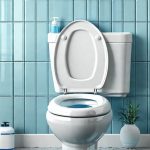Urinary tract infections (UTIs) are incredibly common, affecting millions of people each year – disproportionately women, but certainly not exclusively. While often manageable with appropriate medical care, the simple act of using a public restroom can become a source of significant anxiety and discomfort for those experiencing UTI symptoms or trying to prevent one. It’s understandable: concerns about hygiene, potential contamination, and simply needing to go frequently create a complex emotional and practical challenge. This isn’t just about avoiding germs; it’s about navigating everyday life with an added layer of vulnerability and the desire to minimize discomfort.
The fear surrounding public restroom use with UTIs often stems from misconceptions and a lack of concrete strategies. Many believe that public restrooms are inherently “dirty” and will inevitably worsen symptoms or cause infection, leading to avoidance behaviors that can ultimately impact daily routines and quality of life. However, with awareness, preparation, and the right approach, it’s entirely possible to manage this aspect of living with UTIs – or even proactively reducing risk while traveling or away from home. This article aims to provide practical tips and information to help you navigate public restrooms with more confidence and less anxiety when dealing with UTI concerns.
Minimizing Risk & Maximizing Hygiene
Public restrooms, by their nature, are shared spaces, and therefore carry a higher potential for bacterial contact. However, they aren’t necessarily breeding grounds for UTIs; it’s the specific bacteria – most commonly E. coli – that can cause infection if introduced into the urinary tract. The key isn’t avoiding public restrooms altogether (which is often impractical), but rather minimizing exposure and practicing good hygiene habits. One of the biggest concerns is contact with surfaces like toilet seats, door handles, and faucets. While direct seat-to-skin contact is less likely to cause an infection than previously thought, it’s still a valid concern for many.
Several simple steps can significantly reduce your risk: – Consider using disposable toilet seat covers if available (although their effectiveness is debated, the peace of mind they provide is valuable). – Hover slightly above the seat when possible, although this isn’t always feasible or comfortable. – Thoroughly wash your hands with soap and water after using the restroom – a crucial step regardless of UTI concerns. – Use a paper towel to turn off the faucet and open the door, avoiding direct contact with potentially contaminated surfaces.
Beyond these immediate actions, preventative measures before leaving home can also be beneficial. Staying well-hydrated helps flush out your urinary tract, reducing bacterial concentration. Avoiding overly tight clothing allows for better airflow and reduces moisture buildup, which can create a favorable environment for bacteria. If you are prone to UTIs, discussing proactive strategies with your healthcare provider – such as D-mannose supplements or cranberry products (although evidence is mixed) – might be worthwhile. Remember that these aren’t substitutes for medical treatment but may offer some preventative support.
Post-Restroom Care & Symptom Management
Even with the best preventative measures, those experiencing UTI symptoms may feel anxious about using public restrooms due to increased urgency and discomfort. The act of urination itself can sometimes exacerbate pain or burning sensations. Therefore, having a plan for post-restroom care is essential. This begins with continuing good hygiene practices – washing hands thoroughly and avoiding touching your genital area unnecessarily.
After urinating, gently pat dry from front to back to prevent the spread of bacteria. Avoid harsh soaps or scented wipes that can irritate sensitive tissues. If you have a tendency towards post-void dribbling (a common symptom of UTIs), carrying a small, absorbent pad can provide reassurance and comfort. It’s also important to remember not to hold your urine for extended periods; frequent urination is often part of the UTI experience, and trying to suppress it can worsen symptoms and potentially increase the risk of bladder irritation.
If you are experiencing significant pain or discomfort during urination, consider applying a warm compress to your lower abdomen or pelvic area after using the restroom. This can help soothe muscle spasms and reduce overall discomfort. It’s crucial to listen to your body and adjust your routine as needed. If symptoms worsen despite these measures, seeking medical attention promptly is essential.
Dealing with Urgency & Frequency
UTI urgency – that sudden, overwhelming need to urinate – can make navigating public restrooms particularly stressful. The fear of not finding a restroom in time or encountering an unsanitary one can lead to anxiety and even avoidance behaviors. Planning your route ahead of time is the first step: – Identify potential restroom locations along your journey (using apps or maps). – Be aware of the availability of restrooms at your destination.
If you experience sudden urgency while away from a restroom, try these techniques: – Practice deep breathing exercises to calm yourself and potentially reduce the sensation. – Distract yourself with conversation or mental tasks. – Avoid drinking excessive amounts of fluids until you can access a restroom. Remember that urgency is often a symptom of the UTI itself and doesn’t necessarily mean you need to rush immediately; it’s about managing your anxiety around it.
It’s also important to differentiate between true urinary urgency (a sudden, strong urge) and feelings of discomfort or pressure. Sometimes, simply acknowledging and accepting the sensation can help reduce anxiety. If you are prone to frequent urination due to a UTI, consider carrying a small, discreet hydration pack or water bottle with you. This allows you to stay hydrated without relying solely on public drinking fountains, which may also raise hygiene concerns.
Packing a “UTI Preparedness Kit”
For those who frequently experience UTIs or are particularly anxious about using public restrooms, assembling a small “preparedness kit” can provide peace of mind and practical support. This kit might include: – Antibacterial wipes for cleaning surfaces (though remember that overusing antibacterial products can contribute to antibiotic resistance). – Disposable toilet seat covers. – A small package of absorbent pads or liners. – Hand sanitizer.
- Travel-sized pain relief medication (as recommended by your healthcare provider). Consider adding a sealed, resealable bag for disposing of used sanitary items discreetly. The contents of the kit should be tailored to your individual needs and comfort level. Importantly, this isn’t about creating an overly sterile environment; it’s about having tools available to manage anxiety and maintain hygiene in situations where you feel vulnerable. Remember that the goal is empowerment – taking control of your experience rather than letting UTI concerns dictate your life.
Navigating Travel & Long Journeys
Traveling can exacerbate UTI-related anxieties, as access to clean and comfortable restrooms may be limited. When traveling: – Stay well-hydrated throughout your journey. – Avoid caffeine and alcohol, which can irritate the bladder. – Pack your “UTI preparedness kit.” – Research restroom availability at airports, train stations, and rest stops along your route.
Consider using a bidet attachment for travel or carrying portable cleansing wipes designed for intimate hygiene. If you are flying, inform the flight attendant of your condition; they may be able to assist with finding accessible restrooms or providing extra assistance. Long car rides can be particularly challenging due to limited restroom breaks. Plan frequent stops and consider bringing a portable urinal or bedpan if necessary (though this is a personal decision and depends on comfort level). The key is proactive planning and preparation to minimize stress and ensure you have the resources you need to manage your symptoms effectively while away from home.





















